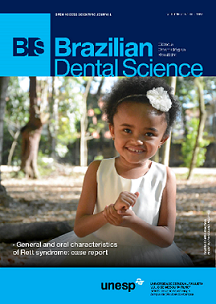Stress and strain distributions on short implants with two different prosthetic connections – an in vitro and in silico analysis
DOI:
https://doi.org/10.14295/bds.2017.v20i3.1433Resumo
Objective: An ideal biomechanics minimizes the stress between implant and bone that can provide success for osseointegrated implants. This study evaluated the strain concentration in surrounding tissue and stress in the components of two implants with different prosthetic connections through an in vitro and in silico methods. Methods: Twenty polyurethane blocks were divided into two groups (n=10) followed by the installation of internal hexagon (IH) (AS Technology – Titanium Fix, São José dos Campos, Brazil) or locking taper implants (LT) (Bicon Dental Implants). For strain gauge (SG) method, four sensors were placed around the implants. For finite element analysis (FEA), the same block was modeled and analyzed. An axial load (30 kgf) was applied for both methodologies. The values of stress and strain were analyzed for correlation to SG. Results: For SG, LT presented a mean of strain most aggressive (-932) than IH (-632). For FEA, LT showed less stress (-547) then IH (-1169). Conclusion: For two implant’s system, microstrain values capable to induce unwanted bone remodeling were not measured. However, for IH implant, the presence of a retention screw has the disadvantage to concentrate stress while a solid abutment dissipates the axial load through the implant that suggests a better performance for LT group.
Keywords: Finite elements analyses; Dental implant; Strain gauge.
Downloads
Downloads
Arquivos adicionais
Publicado
Como Citar
Edição
Seção
Licença
TRANSFERÊNCIA DE DIREITOS AUTORAIS E DECLARAÇÃO DE RESPONSABILIDADE
Toda a propriedade de direitos autorais do artigo "____________________________________________________________________" é transferido do autor(es) para a CIÊNCIA ODONTOLÓGICA BRASILEIRA, no caso do trabalho ser publicado. O artigo não foi publicado em outro lugar e não foi submetido simultaneamente para publicação em outra revista.
Vimos por meio deste, atestar que trabalho é original e não apresenta dados manipulados, fraude ou plágio. Fizemos contribuição científica significativa para o estudo e estamos cientes dos dados apresentados e de acordo com a versão final do artigo. Assumimos total responsabilidade pelos aspectos éticos do estudo.
Este texto deve ser impresso e assinado por todos os autores. A versão digitalizada deverá ser apresentada como arquivo suplementar durante o processo de submissão.




























